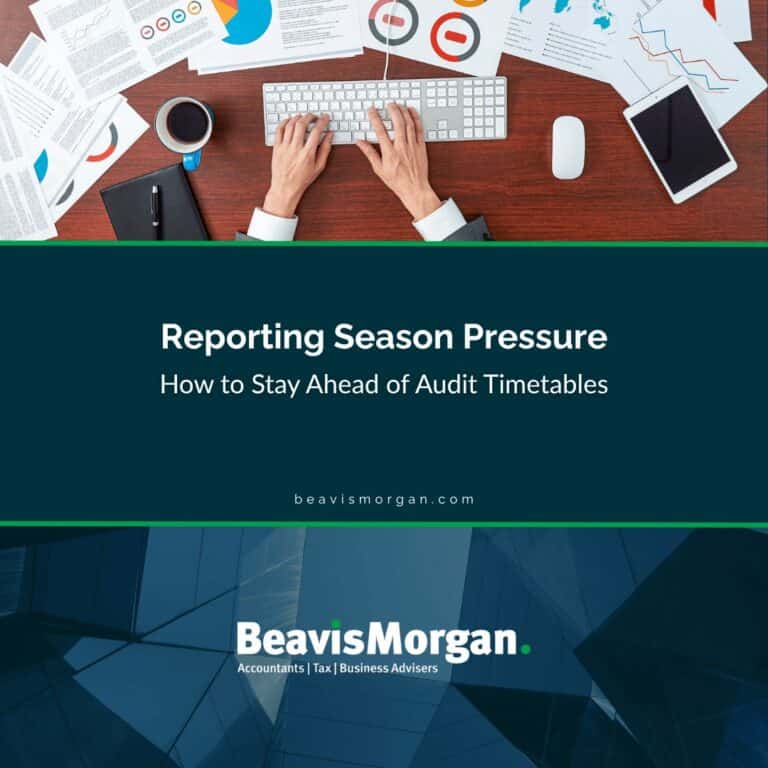As the 2025-26 tax year approaches, business owners must take proactive steps to optimise their tax position, manage cash flow, and ensure compliance in an increasingly complex regulatory landscape. At Beavis Morgan, we work closely with SMEs, entrepreneurs, and high-net-worth individuals to build tailored strategies that not only meet compliance obligations but also strengthen financial resilience.
In this article, we highlight essential tax planning actions to consider now to get ahead of the 2025-26 tax year.
-
Review Dividend and Salary Strategies
With frozen income tax thresholds continuing to push more business owners into higher tax brackets, it is critical to reassess the most tax-efficient way to extract profits from your business.
- Optimise the balance between salary and dividends to make the most of personal allowances, the dividend allowance, and basic rate thresholds.
- Consider family income splitting where appropriate, particularly if family members are involved in the business.
- Plan dividend payments to utilise any remaining lower-rate band before the end of the current tax year.
At Beavis Morgan, we help clients model different scenarios to determine the most tax-efficient remuneration structures for directors and shareholders.
-
Make the Most of Allowances and Reliefs
Several valuable allowances and reliefs are available to business owners, and it is important to ensure they are fully utilised before the year-end.
- Annual Investment Allowance (AIA): Claim up to £1 million of qualifying capital expenditure immediately against profits.
- R&D Tax Relief: Businesses investing in innovation could benefit from valuable R&D tax credits or enhanced deductions.
- Pension Contributions: Contributions up to £60,000 per annum may be eligible for tax relief. Pension contributions can also help manage exposure to higher tax rates.
- Capital Gains Tax (CGT) Annual Exemption: Plan asset disposals to utilise the £3,000 CGT annual exemption for individuals (£6,000 for couples).
Maximising these allowances can significantly reduce taxable profits and overall tax bills.
-
Prepare for Making Tax Digital (MTD)
Although the full rollout of Making Tax Digital for Income Tax (MTD ITSA) has been delayed until 6 April 2028 for those with qualifying income over £20,000, businesses should start preparing early.
- Review current bookkeeping systems and transition to MTD-compliant software.
- Implement quarterly reporting processes to avoid disruption.
- Train internal teams on digital submission requirements.
Early adoption of digital systems ensures a smoother transition and strengthens financial visibility, an important advantage in volatile markets.
-
Stay Ahead of Compliance Changes
The 2025 Spring Statement confirmed that HMRC will receive significant extra funding to tackle tax evasion and non-compliance, with a 20% increase in prosecutions targeted.
- Maintain detailed financial records to support tax filings.
- Prepare for increased HMRC scrutiny by ensuring documentation is accurate and accessible.
- Work with a trusted adviser to complete tax returns correctly and to spot potential risks before HMRC does.
Avoiding penalties and late payment interest, particularly with penalties for unpaid income tax increasing from 5% to 10% in 2025/26, must be a priority for all business owners.
-
Reassess Business Structures
Changing trading conditions and tax policies may make it worthwhile to reassess whether your current business structure remains fit for purpose.
- Limited company vs sole trader: Companies offer tax deferral opportunities and limited liability but carry higher compliance costs.
- Group structures: Holding companies can protect assets and optimise tax reliefs.
- Family investment companies: A valuable structure for passing wealth efficiently to the next generation.
Our team can guide you through restructuring options, helping you mitigate tax and plan for the long-term.
-
Plan for Succession and Exit
Succession and exit planning should not be left until the last minute. Rising Capital Gains Tax rates for Business Asset Disposal Relief from 6 April 2025 will make timing even more important.
- Consider share transfers to family members early, to lock in current CGT rates.
- Review eligibility for Business Property Relief (BPR) for Inheritance Tax.
- Prepare businesses for sale by reviewing key contracts, operations, and profitability.
If a sale or succession is on your horizon within the next few years, now is the time to start the planning process.
-
Review Debt and Cash Flow Management
The economic outlook remains fragile, with the Office for Budget Responsibility (OBR) downgrading growth forecasts. Prudent financial management is crucial:
- Refinance debt while interest rates remain relatively stable.
- Build cash reserves to weather unexpected costs or revenue disruptions.
- Consider R&D tax credit advances to improve cash flow.
A proactive cash management strategy can provide a crucial buffer in uncertain times.
Conclusion: Act Now, Plan Ahead
The 2025-26 tax year presents challenges — from fiscal drag and compliance pressures to the transition toward digital reporting. But it also offers opportunities for well-prepared business owners to protect and enhance their financial position.
At Beavis Morgan, our team of tax and business advisers work with you to develop practical, commercially focused strategies tailored to your unique circumstances.
Call, or email info@beavismorgan.com to arrange a confidential conversation about your 2025-26 tax planning and business strategy.





